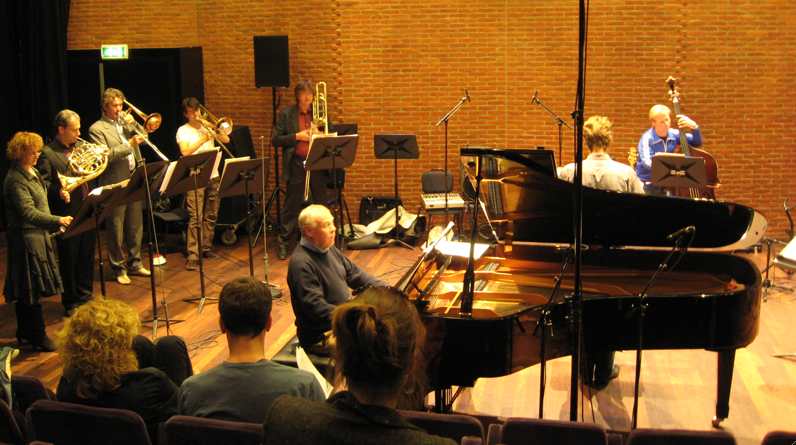I finally got a recording of my piano concerto Sunken City – by recording it off of Dutch radio via the internet:
First movement: Before (7:43)
Second movement: After (22:19)
The recording is of the premiere in Rotterdam, which had a few more mistakes than the next evening’s concert in Amsterdam, but the spirit of it is quite nice. The ensemble is the Orkest de Volharding, the crackerjack wind and brass ensemble founded by Louis Andriessen in 1972, conducted by the young but impressively expert Finnish conductor Jussi Jaatinen. The soloist is Geoffrey Douglas Madge, an Australian pianist living in Amsterdam since the ’70s. Few I talk to in the U.S. have heard of him, but he long ago recorded the complete Busoni piano music for Philips, and gave the Chicago premiere of Sorabji’s massive Opus Clavicembalisticum in the mid-’80s, so he’s been a big figure on my radar screen for a couple of decades. It was a great honor to have worked with him, and I found him a kindred spirit and a convivial conversationalist. Here’s a photo of him rehearsing just before the premiere (the other half of the ensemble is outside the picture frame):

Of course, I got blasted in the local Amsterdam Picayune by the same critic whom all the Dutch composers hate because he’s blasted them as well. The only stated complaint was that the piece was too long, which is the most superficial kind of comment; I have tried, throughout my critical career, to avoid ever simply calling a piece too long, because that doesn’t mean anything. If Tristan isn’t “too long” at four hours, how can anything shorter be “too long”? What a decent critic would say instead is something about the structure of the piece that makes the overall form unwieldy. Typically such a work will be unclearly articulated, with too much sectional variety to grasp as a large structure. But in this case, the long second movement is a simple alternation of tutti sections and piano solos, ABABA in that respect after a short introduction of piano chords. It is also a chaconne, one of the simplest of forms, interrupted by a jazz section quoting Jelly Roll Morton’s “Dead Man’s Blues,” and returning at the end to the opening chords in a freer order. The chaconne does contain 17 chords, because I needed at the beginning to suggest the seeming eternity of New Orleans victims waiting for help. I have my qualms about the work’s orchestration, transitions, and other details, but there is nothing about it I am more certain about than that it is not too long. (While composing I even found the piece getting too large and compressed some sections.) And no composer in the world knows better than I do exactly what such reviews are worth.
Much more to the point, probably, is that the second movement is rather sad and Romantic, and as one experienced Amsterdammer warned me, “The Dutch critics don’t like sentimentality.” The piece is, I’ll remind you, an homage to and memorial for New Orleans. I’ve already blogged the program notes, so won’t repeat them here. You can download a PDF score here if you want.
I have a didactic point to make about the performance. You will notice that some of the solos are rather jazzed up, with tasteful pitch bends. I did not notate these. They are, generally speaking, exactly what I wanted. The Volharding players, being smart and sensitive musicians, inferred from the nature of the music precisely what would sound appropriate and played it creatively and in the right spirit. I didn’t coach them on that at all – they were already playing it that way when I arrived. So much for the Midtown fallacy that every nuance has to be exactly notated or no one will know how to play your music. Many Pulitzer- and Grauwemeyer-winning composers would say that my score to Sunken City is “undermarked,” and thus “unprofessional” – and yet a European ensemble, who had never heard my music before, divined exactly the degree of looseness that would make me happy, and achieved it with no input from me. How is that possible? Surely I can’t be right in what I’ve been saying for twenty years, that if you write music clearly enough you can trust smart, sensitive performers to play beyond the notation to find the right feel for the music? Or does this performance, perhaps, prove the orchestral hotshots’ mandate about notational exactitude to be the ideological horseshit it’s always been?
With that in mind, enjoy.
UPDATE: Friend John Luther Adams provides a comforting thought: “Your piece isn’t too long. That critic is too short.”
